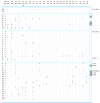Hepatitis B virus genome asymmetry in hepatocellular carcinoma
- PMID: 24829649
- PMCID: PMC3990121
Hepatitis B virus genome asymmetry in hepatocellular carcinoma
Abstract
Background: The association between hepatitis B virus (HBV) mutations and hepatocarcinogenesis were reported in the literature. Preference for G over C in the leading DNA strand has been reported to account for the asymmetry in nucleotide (nt) composition. The aim of this study was to analyze the complete genome sequence and compositional asymmetry of HBV in different stages of hepatitis B.
Methods: Full genome sequencing of 24 patients with chronic hepatitis B, some of whom also had cirrhosis and hepatocellular carcinoma (HCC) was performed. Mutations analysis was implemented in a comparison with a HBV genotype D reference from an international DNA database. CpGProD, a web-based application, was used to evaluate CG content and predict CpG islands.
Results: All strains were 3182 base pairs (bp) in length, except for two cases of HCC in which 9 and 21 nt, respectively, were deleted in preS2. The genetic relatedness of these isolates was 97%-100%. There were common CpG-rich regions in all 24 isolated full genome sequences, however a strong negative GC skew for forming a CpG island in the minus strand were exhibited in overlap with enhancer I in three HCC patients, a cirrhotic patient and three with chronic hepatitis.
Conclusion: The high percentage of sequence identity between HBV isolates in our patients demonstrates that genomic factors, except for genotype, are involved in hepatocarcinogenesis. Variations in GC content which were caused by a different spectrum of mutations may affect DNA compositional asymmetry and epigenetic modification of HBV DNA in HCC.
Keywords: HBV genome CpG; Hepatitis B virus (HBV); Hepatocellular carcinoma (HCC).
References
-
- Lobry JR. Asymmetric substitution patterns in the two DNA strands of bacteria. Mol Biol Evol. 1996;13:660–5. - PubMed
LinkOut - more resources
Full Text Sources
Research Materials
Miscellaneous


